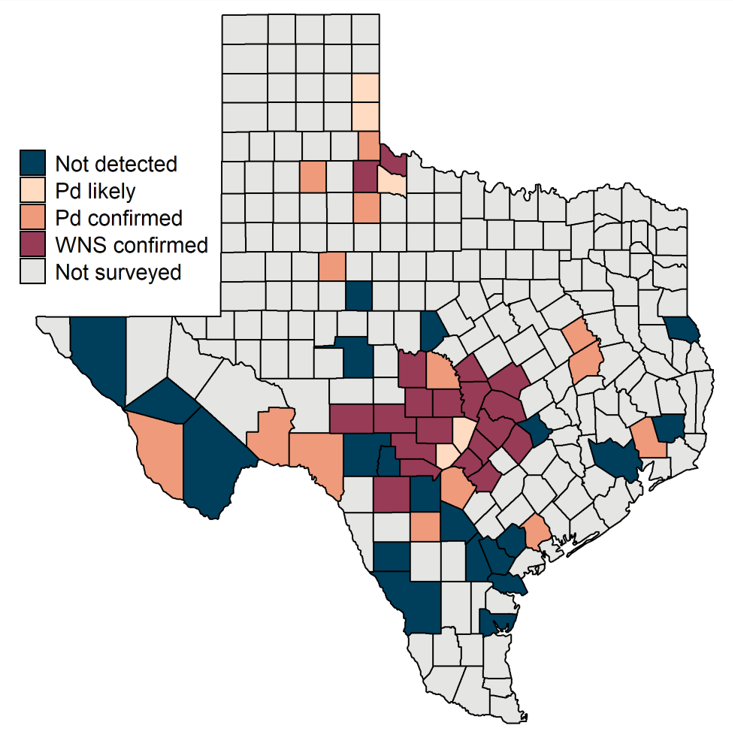Commission Meeting Agenda Item No. 5
Presenter: Dr. Nathan Fuller
Briefing
White-Nose Syndrome
January 26, 2023
I. Executive Summary: Pseudogymnoascus destructans (Pd), the fungus that causes White-Nose Syndrome (WNS) in bats, is impacting Texas bats. Staff will present details on and discuss plans for addressing the disease.
II. Discussion: Since the discovery of WNS in New York State in 2006, millions of bats have perished as the disease has spread through the eastern United States and Canada.
In early 2017, Pd was detected in Texas for the first time by Texas Parks and Wildlife Department (TPWD)-funded research projects with Texas A&M University and Bat Conservation International. In 2018, Pd was found in Central Texas in Kendall and Blanco counties, and in 2019, there was a significant increase in detections in and around central Texas. In 2020, TPWD biologists confirmed the presence of WNS, the disease caused by the fungus, for the first time in Gillespie County in a cave myotis (Myotis velifer), thought to be the second most abundant bat species in Texas. The fungus has now been detected in 37 Texas counties, and WNS has been confirmed in 20 counties. Uvalde County now contains the southernmost place of detection of WNS in North America.
The four species of bats that have been found carrying Pd in Texas are the tri-colored bat (Perimyotis subflavus), the cave myotis, the Townsend’s big-eared bat (Corynorhinus townsendii), and the Mexican free-tailed bat (Tadarida brasiliensis). Due to population declines from WNS, the tri-colored bat has recently been recommended for endangered species listing by the United States Fish and Wildlife Service. While Mexican free-tailed bats do not appear to develop WNS after contracting Pd, staff are concerned that their long-distance migrations may carry the Pd pathogen great distances into unaffected regions, including the western United States and Central and South America.
As of the end of 2022, WNS has only been detected in Texas from one bat species (cave myotis). Of the 33 species in Texas, seven have been documented with WNS in other states. While susceptibility of many of the species found in Texas to WNS is currently unknown, staff believes that at least nine species are at risk from the disease.
Staff are currently managing several projects related to WNS response and population monitoring of at-risk bat species, including conducting migratory and population genetic studies of cave myotis; monitoring statewide distribution, status, and trends of bat populations using acoustic and cave roost surveys; and participating in studies evaluating the efficacy of experimental treatments for WNS. TPWD was awarded a grant by the National Fish and Wildlife Foundation to conduct experimental treatments on tri-colored bats at several large roost sites in culverts in East Texas. TPWD is also partnering with the National Wildlife Health Center and Bat Conservation International to test experimental vaccine treatments at the largest cave myotis colonies in the Texas Panhandle.
Attachment – 1
Commission Agenda Item No. 5
Exhibit A
Map of Pseudogymnoascus destructans (Pd) and White-Nose Syndrome (WNS) detections in Texas
